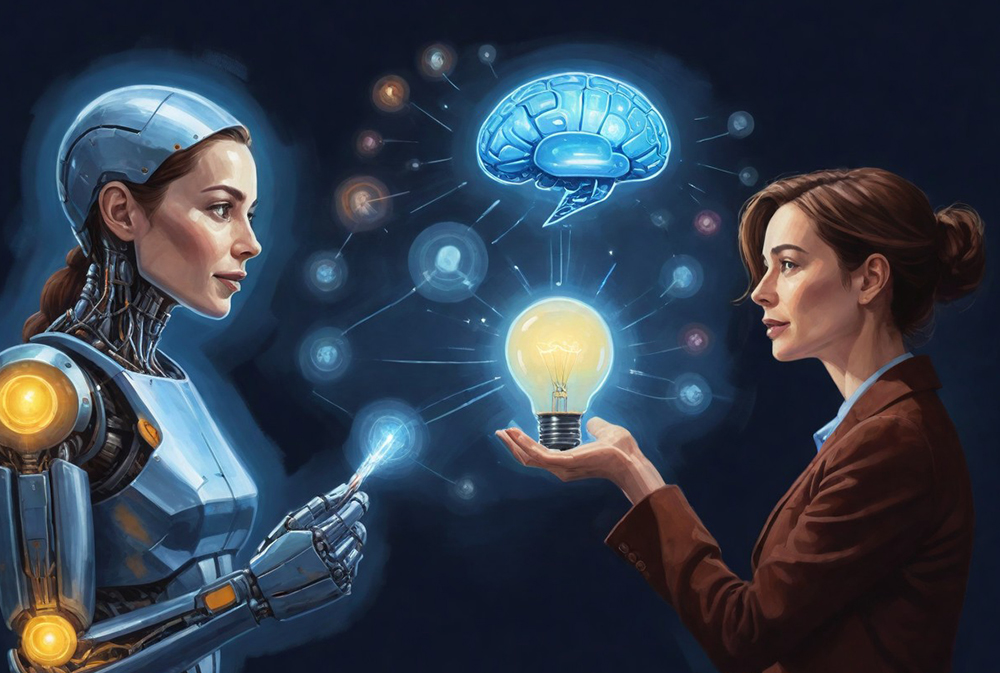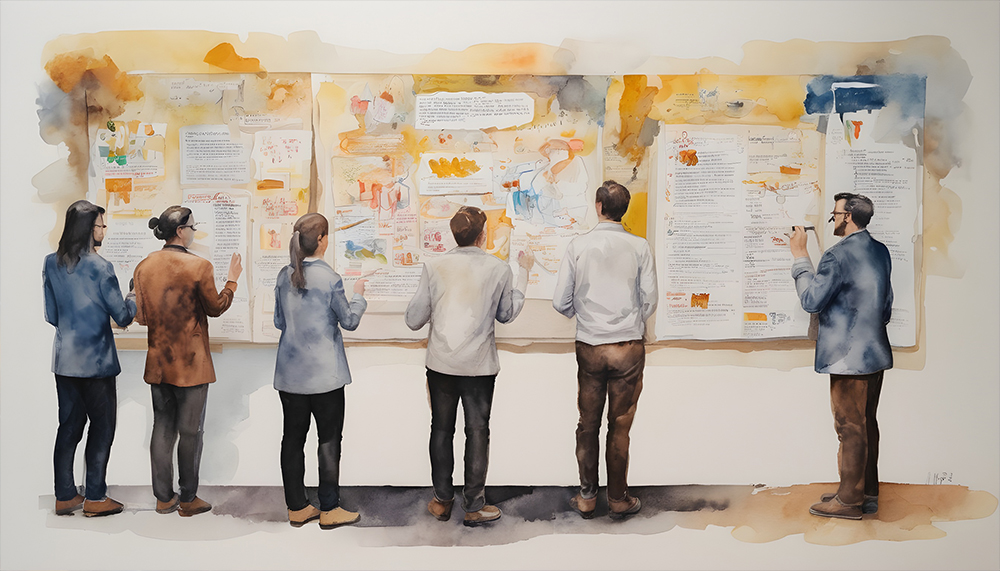Human Genius, Design Thinking, and Artificial Intelligence: A New Paradigm for Leadership
Author: Preeta Chandran, CEO-ewandzdigital
The landscape of leadership is undergoing a significant transformation. The convergence of human genius, design thinking, and artificial intelligence (AI) marks a significant shift in approaches and outcomes. In this article, I share my views on how this synergy is reshaping problem-solving methodologies and leading to innovative solutions across various domains. This new approach emphasizes a dynamic interplay between human genius, AI capabilities, and the problem-solving framework of design thinking, empowering leaders to navigate complex challenges and drive innovation.

Human Genius: The Foundation of Thought, Empathy, and Creativity
At the core of this new paradigm lies human genius – the amalgamation of creativity, critical thinking, and domain expertise. Design thinking, a human-centered approach to innovation, emphasizes empathy, ideation, prototyping, and testing. Here are some key elements of human genius as the foundation of thought, creativity, and empathy:
- Divergent thinking: Human genius fosters divergent thinking, enabling individuals to explore multiple perspectives and generate novel solutions. For example, in product design, human designers leverage their intuition and empathy to understand user needs and create intuitive experiences that resonate with users on an emotional level.
- Strategic Thinking: Leaders leverage their foresight and ability to analyze complex situations to set clear goals and develop actionable plans.
- Empathy and Emotional Intelligence: Understanding the needs, motivations, and emotions of individuals and teams is essential for fostering collaboration and building trus.
- Creativity and Innovation: Leaders who can think outside the box and embrace new ideas are well-positioned to drive progress in a rapidly changing environment.
Design Thinking: Human-Centered Approach

- This methodology emphasizes understanding the needs of users or stakeholders, fostering empathy, and iteratively developing solutions that address those needs effectively.
- Prototyping and Testing: Design Thinking encourages rapid prototyping and testing of ideas, allowing for quick feedback and course correction, leading to more effective solutions.
- Collaborative Problem Solving: This framework fosters a collaborative environment where diverse perspectives are valued, leading to more innovative and comprehensive solutions.
Artificial Intelligence: Enhancing Problem-Solving with Data and Automation
Artificial intelligence augments human capabilities by processing vast amounts of data, identifying patterns, and generating insights at speeds unimaginable to humans alone. Machine learning algorithms, for instance, can analyze consumer behavior data to predict trends, enabling businesses to tailor their strategies accordingly. Automation streamlines repetitive tasks, freeing up human resources to focus on higher-order thinking and creativity. For instance, in healthcare, AI-powered diagnostic tools analyze medical images with unprecedented accuracy, aiding clinicians in early detection and treatment planning.
Gen AI: Collaboration Between Humans and Machines
Gen AI represents the symbiotic relationship between human intelligence and AI capabilities, where each complements the other's strength. By integrating human creativity and empathy with AI's analytical prowess and efficiency, Gen AI transcends traditional problem-solving approaches.
Augmented Creativity: Gen AI can assist with brainstorming new ideas, generating design variations, and exploring alternative solutions, expanding the creative scope for leaders.
The New Landscape of Leadership: A Synergistic Approach
This new paradigm focuses on a synergistic blend of these three elements:
- Leveraging AI for Informed Decisions: Leaders can utilize AI-powered data analysis to gain a deeper understanding of the situation, identify potential challenges and opportunities, and make data-driven choices.
- Human Expertise in Strategic Direction: While AI provides valuable insights, human leaders play a critical role in setting the strategic direction, incorporating ethical considerations, and making decisions based on their judgment and experience.
- Design Thinking for Creative Problem Solving: The human-centered approach and iterative nature of Design Thinking empower leaders to involve stakeholders, identify root causes of problems, and develop innovative solutions that effectively address the identified needs.
This collaborative approach equips leaders with the following advantages:
- Enhanced Decision-Making: By combining human intuition with data-driven insights from AI, leaders can make more informed and effective decisions.
- Increased Innovation: AI-powered idea generation coupled with the human capacity for creative exploration fosters a culture of innovation, leading to the development of novel solutions.
- Improved Problem-Solving: The structured approach of Design Thinking, combined with AI's analytical capabilities, allows leaders to tackle complex challenges in a systematic and efficient manner.
The Road Ahead: A Call for Responsible Leadership

In this evolving landscape, responsible leadership is paramount. Leaders must:
- Prioritize the ethical use of AI: Ensure that AI is employed responsibly, avoiding biases and safeguarding data privacy.
- Foster a culture of human-AI collaboration: Leaders must bridge the gap between human and AI capabilities, fostering a collaborative environment where both strengths are valued and utilized effectively.
- Develop the necessary skills: Leaders need to equip themselves with the skills to understand and leverage AI effectively, while also nurturing their human qualities like critical thinking, empathy, and creativity.
The future of leadership lies not in replacing human genius with AI, but in harnessing the power of both. By embracing this new paradigm that combines human expertise with AI capabilities and the Design Thinking framework, leaders can navigate the complexities of the modern world, drive innovation, and create a more positive impact.
Tags: #Leadership, #Technology, #AI, #ArtificialIntelligence, #Creativity, #HumanGenius, #Empathy, #DesignThinking, #StrategicThinking, #DataScience, #Analytics

